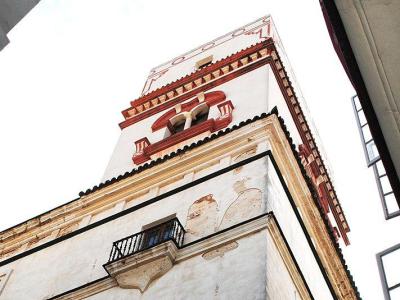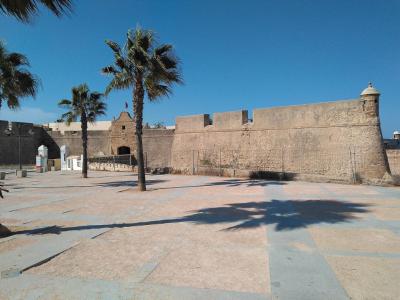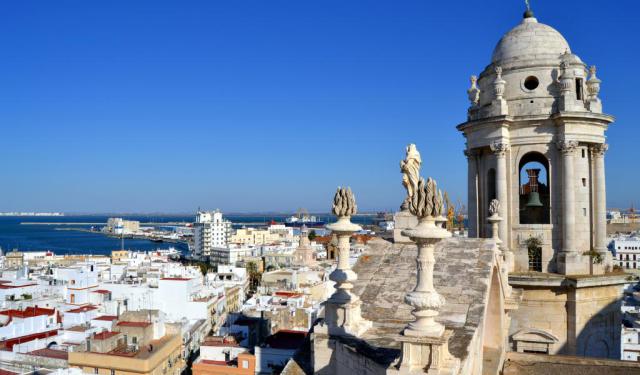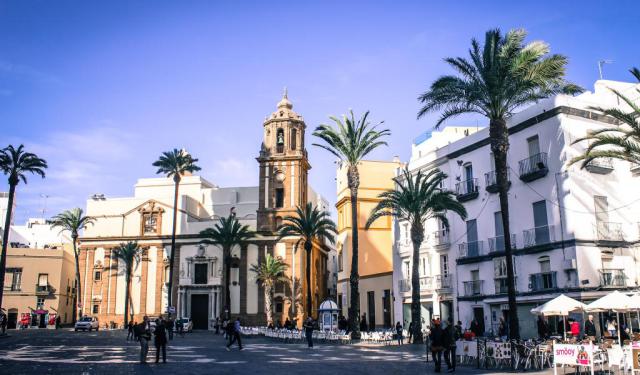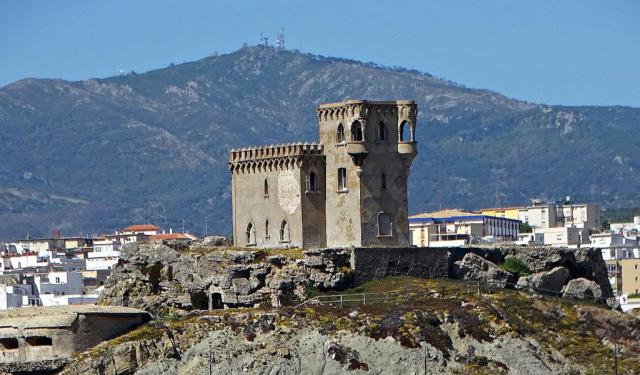
Cadiz's Old Fortifications Walking Tour (Self Guided), Cadiz
"Cadiz is a silver cup, surrounded by walls and kissed by the sea," goes the expression highlighting the city's unique location and historic fortifications. Indeed, throughout its more than 3,000-year-long history, Cadiz has been fortified numerous times to ward off naval attacks and invasions by land.
After Christopher Columbus launched his second and fourth voyages to the New World from Cadiz, treasures from the Americas, collected during the Age of Exploration, began to pour in. The city's prosperity grew exponentially and so, unfortunately, did the enemies' envy.
Lured by its riches, Cadiz was raided and destroyed by the English pirate Frances Drake in the late 16th century. In response to that, King Phillip II ordered to design an impenetrable defense. The latter took 25 years to build, encircling the city with a curtainwall and intermittent guard towers, ramparts, and bastions armed with cannons.
Around the same time, the Castillo de Santa Catalina, on La Caleta beach, was also finished, with two bulwarks added to the north part of town in the late 17th century. The construction of the Castillo de San Sebastian followed in 1706. The exhaustive fortification plan worked, and all the subsequent attacks by the English and French in the 18th and 19th centuries were successfully repelled.
Most of the old-time defenses still in place are an integral part of the city's urban fabric and are yours to explore and enjoy. These fortifications are a testament to the rich military history of Cadiz and serve as a reminder of its strategic importance and the role it once played as a gateway, on the western edge of Europe, to the New World and beyond.
After Christopher Columbus launched his second and fourth voyages to the New World from Cadiz, treasures from the Americas, collected during the Age of Exploration, began to pour in. The city's prosperity grew exponentially and so, unfortunately, did the enemies' envy.
Lured by its riches, Cadiz was raided and destroyed by the English pirate Frances Drake in the late 16th century. In response to that, King Phillip II ordered to design an impenetrable defense. The latter took 25 years to build, encircling the city with a curtainwall and intermittent guard towers, ramparts, and bastions armed with cannons.
Around the same time, the Castillo de Santa Catalina, on La Caleta beach, was also finished, with two bulwarks added to the north part of town in the late 17th century. The construction of the Castillo de San Sebastian followed in 1706. The exhaustive fortification plan worked, and all the subsequent attacks by the English and French in the 18th and 19th centuries were successfully repelled.
Most of the old-time defenses still in place are an integral part of the city's urban fabric and are yours to explore and enjoy. These fortifications are a testament to the rich military history of Cadiz and serve as a reminder of its strategic importance and the role it once played as a gateway, on the western edge of Europe, to the New World and beyond.
How it works: Download the app "GPSmyCity: Walks in 1K+ Cities" from Apple App Store or Google Play Store to your mobile phone or tablet. The app turns your mobile device into a personal tour guide and its built-in GPS navigation functions guide you from one tour stop to next. The app works offline, so no data plan is needed when traveling abroad.
Cadiz's Old Fortifications Walking Tour Map
Guide Name: Cadiz's Old Fortifications Walking Tour
Guide Location: Spain » Cadiz (See other walking tours in Cadiz)
Guide Type: Self-guided Walking Tour (Sightseeing)
# of Attractions: 6
Tour Duration: 2 Hour(s)
Travel Distance: 4.3 Km or 2.7 Miles
Author: nataly
Sight(s) Featured in This Guide:
Guide Location: Spain » Cadiz (See other walking tours in Cadiz)
Guide Type: Self-guided Walking Tour (Sightseeing)
# of Attractions: 6
Tour Duration: 2 Hour(s)
Travel Distance: 4.3 Km or 2.7 Miles
Author: nataly
Sight(s) Featured in This Guide:
- Puerta de Tierra (Earth Gate)
- Arco de los Blanco (Arch of the Whites)
- Torre Tavira (Tavira Tower)
- Baluarte de la Candelaria (Candelaria Bastion)
- Castillo de Santa Catalina (Castle of Santa Catalina)
- Castillo de San Sebastian (Castle of San Sebastian)
1) Puerta de Tierra (Earth Gate)
Earth Gate (Puerta de Tierra) is a significant cultural and historical landmark in Cádiz. It stands at the entrance of the old town and holds great value as a heritage site. The gate was built during the 16th century, replacing the old medieval walls, which could no longer accommodate the city's growth. In 1574, two bastions were added to the gate for further protection. It was in the 18th century that the gate gained its final appearance.
The central feature of the Earth Gate is a low tower surrounded by a marble frontispiece, which was built in 1756. The frontispiece is adorned with the royal shield, the coat of arms of the city, and a military allegory. The building's facade was later enhanced with a magnificent marble portico in the form of a triumphal arch, designed by architect Torcuato Cayón.
During the early 20th century, there were proposals to demolish the entire complex due to its extension outside the walls. However, instead of being demolished, the moats were covered, and two large arches were created to allow the passage of vehicles. Two marble obelisks were also placed in the central square at the entrance of the city's port, dedicated to Cádiz's patron saints, San Servando and San Germán, and are examples of Baroque art.
Apart from the central vault, tower, and upper promenade, the Earth Gate also houses the Lithographic Workshop Museum and the Ibero-American Puppet Museum, which displays the city's culture and history, making it an excellent destination for tourists interested in the city's heritage.
The central feature of the Earth Gate is a low tower surrounded by a marble frontispiece, which was built in 1756. The frontispiece is adorned with the royal shield, the coat of arms of the city, and a military allegory. The building's facade was later enhanced with a magnificent marble portico in the form of a triumphal arch, designed by architect Torcuato Cayón.
During the early 20th century, there were proposals to demolish the entire complex due to its extension outside the walls. However, instead of being demolished, the moats were covered, and two large arches were created to allow the passage of vehicles. Two marble obelisks were also placed in the central square at the entrance of the city's port, dedicated to Cádiz's patron saints, San Servando and San Germán, and are examples of Baroque art.
Apart from the central vault, tower, and upper promenade, the Earth Gate also houses the Lithographic Workshop Museum and the Ibero-American Puppet Museum, which displays the city's culture and history, making it an excellent destination for tourists interested in the city's heritage.
2) Arco de los Blanco (Arch of the Whites)
The Arch of the Whites (Arco de los Blanco) is an ancient Roman gate in the Pópulo neighborhood of Cádiz. It was situated near the Village Castle (Castillo de la Villa), and different constructions were added to the original opening, altering its appearance over time. However, the wide vault that forms the passage has been preserved.
The arch was named after the Bianco or Blanco family, who built a chapel over the main arch in the 17th century. Unfortunately, the chapel no longer exists. The exterior portico of the arch was the main entrance or Land Gate of the medieval town and had pointed arches. It was likely built at the same time as the rest of the fortification and citadel and provided access to the royal butcher shops. Beneath the site of the butcher shops, some of the annexed rooms of the Roman theater of Gades have been discovered.
The Arch of the Whites was originally called Earth Gate (Puerta de Tierra) because it was located in front of the schooner or isthmus. Later it was renamed Santa María, after the suburb it led to. The gate was flanked by two towers of unequal size. The southern tower was one of the cubes of the castle that stood next to the arch.
Today, the Arch of the Whites is a historical monument that attracts many visitors to Cadiz. Although the façade of the arch was dismantled in the 16th century to widen the street, its remaining parts provide a glimpse into the city's rich Roman and medieval history.
The arch was named after the Bianco or Blanco family, who built a chapel over the main arch in the 17th century. Unfortunately, the chapel no longer exists. The exterior portico of the arch was the main entrance or Land Gate of the medieval town and had pointed arches. It was likely built at the same time as the rest of the fortification and citadel and provided access to the royal butcher shops. Beneath the site of the butcher shops, some of the annexed rooms of the Roman theater of Gades have been discovered.
The Arch of the Whites was originally called Earth Gate (Puerta de Tierra) because it was located in front of the schooner or isthmus. Later it was renamed Santa María, after the suburb it led to. The gate was flanked by two towers of unequal size. The southern tower was one of the cubes of the castle that stood next to the arch.
Today, the Arch of the Whites is a historical monument that attracts many visitors to Cadiz. Although the façade of the arch was dismantled in the 16th century to widen the street, its remaining parts provide a glimpse into the city's rich Roman and medieval history.
3) Torre Tavira (Tavira Tower) (must see)
The Tavira Tower (Torre Tavira), the watchtower of Cadiz, is more than 149 feet above sea level and the highest point in the Old City. It's part of the House Palace of the Marquises of Recano (Marqueses de Recano). These days, the palace is the home of the Conservatory of Music of Cadiz.
Since the beginning of the 18th century, Cadiz had dominated all trade with the Indies and the Americas. Such a city needs towers to keep an eye on things, especially things coming from over the sea. Cadiz went for it. Today it has over 126 watchtowers, including the Tavira Tower.
The Tavira Tower was built in 1780 as a part of the Palace of the Marqueses, but it was always intended to be a lookout tower. Considering its superior height, it was officially designated as the town's surveillance tower.
In 1787 the palace gave over its function as a residence. It successively was home to the School of Noble Arts, the College of Jesus, Mary and Joseph, the Supreme Court, and finally, the City Hall Conservatory of Music.
Don Antonio Tavira was the first watchman of the tower. He left his name and so much more. In addition to commanding views of Cadiz and its environs, the Tavira Tower also has a Camera Obscura.
In a darkened upper room of the tower, a guide operates the optical system of the Camera Obscura. Images of the sea, monuments, and the city are projected on a round table screen in the center of the room. The session takes about twenty minutes.
In the two other rooms, exhibits explain the evolution of the Camera Obscura and the history of Cadiz in the 18th and 19th centuries. This room is about Cadiz's Golden Age. Finally, there is a panel on the Cortes de Cadiz of 1812. This panel tells the story of Spain's first written constitution, which was written in Cadiz.
Since the beginning of the 18th century, Cadiz had dominated all trade with the Indies and the Americas. Such a city needs towers to keep an eye on things, especially things coming from over the sea. Cadiz went for it. Today it has over 126 watchtowers, including the Tavira Tower.
The Tavira Tower was built in 1780 as a part of the Palace of the Marqueses, but it was always intended to be a lookout tower. Considering its superior height, it was officially designated as the town's surveillance tower.
In 1787 the palace gave over its function as a residence. It successively was home to the School of Noble Arts, the College of Jesus, Mary and Joseph, the Supreme Court, and finally, the City Hall Conservatory of Music.
Don Antonio Tavira was the first watchman of the tower. He left his name and so much more. In addition to commanding views of Cadiz and its environs, the Tavira Tower also has a Camera Obscura.
In a darkened upper room of the tower, a guide operates the optical system of the Camera Obscura. Images of the sea, monuments, and the city are projected on a round table screen in the center of the room. The session takes about twenty minutes.
In the two other rooms, exhibits explain the evolution of the Camera Obscura and the history of Cadiz in the 18th and 19th centuries. This room is about Cadiz's Golden Age. Finally, there is a panel on the Cortes de Cadiz of 1812. This panel tells the story of Spain's first written constitution, which was written in Cadiz.
4) Baluarte de la Candelaria (Candelaria Bastion)
The Candelaria Bastion (Baluarte de la Candelaria) is a fascinating military fortification located at the northern strategic point of Cadiz. The fortress was built in 1672 under the initiative of the governor, Diego Caballero de Illescas, taking advantage of a natural elevation of land to protect the entrance to the port of Cadiz.
The bastion has an irregular triangular plan with the south side open towards the city and the northeast and northwest façades angled defensively towards the bay. Its pointed shape was designed to cope with the force of the sea, and its seaward-facing wall, which had previously served as a seawall, housed cannons that commanded the channels approaching the port.
Over time, the Candelaria Bastion served different functions, such as barracks, engineer's residence, and dovecote for the pigeon service of the Korps Engineers. In the late 19th century, the fortification underwent restoration and was given a cultural destination. It has a hall used for exhibitions, as well as a large courtyard with palm trees where concerts, plays, and carnivals are held. The edifice has served as a headquarters for the Corps of military engineers, and currently, it is designated for use as a permanent exposition space.
The bastion has an irregular triangular plan with the south side open towards the city and the northeast and northwest façades angled defensively towards the bay. Its pointed shape was designed to cope with the force of the sea, and its seaward-facing wall, which had previously served as a seawall, housed cannons that commanded the channels approaching the port.
Over time, the Candelaria Bastion served different functions, such as barracks, engineer's residence, and dovecote for the pigeon service of the Korps Engineers. In the late 19th century, the fortification underwent restoration and was given a cultural destination. It has a hall used for exhibitions, as well as a large courtyard with palm trees where concerts, plays, and carnivals are held. The edifice has served as a headquarters for the Corps of military engineers, and currently, it is designated for use as a permanent exposition space.
5) Castillo de Santa Catalina (Castle of Santa Catalina)
Anglo-Dutch troops and sailors under the command of the Duke of Essex and English Admiral Howard sacked Cadiz in 1596. The city and the Spanish fleet were devastated so badly, Spain was forced to declare bankruptcy the following year.
It was said Spain's disaster happened because "...all were heads of command and none were feet that would follow, and that is how they lost, for not having either hands or feet." King Philip was so set on revenge he dispatched a second and a third armada against England. He lost both, and Cadiz was still devastated. But there was hope.
Hope was a fort. The first bricks of the Castle of Santa Catalina were laid in 1598. However, the castle was not finished until 1621, under the rule of Philip III. The initial architect was Cristobal de Rojas, who had assisted in the building of the royal palace, El Escorial. Rojas died in 1614. All was completed by Ignacio de Sala.
The fort was a template for forts built in Cuba, Mexico, and Puerto Rico. Located at the end of La Caleta beach, the castle has pavilions, barracks, and cisterns. Sentry boxes are at each corner of the seaward walls. There is a waterless moat and a drawbridge. There are magnificent views from the battlements.
The fortress has served as a military prison, but now it is a cultural space with exhibition rooms. It is also a venue for concerts, art, and the Alcances Documentary Film Festival.
It was said Spain's disaster happened because "...all were heads of command and none were feet that would follow, and that is how they lost, for not having either hands or feet." King Philip was so set on revenge he dispatched a second and a third armada against England. He lost both, and Cadiz was still devastated. But there was hope.
Hope was a fort. The first bricks of the Castle of Santa Catalina were laid in 1598. However, the castle was not finished until 1621, under the rule of Philip III. The initial architect was Cristobal de Rojas, who had assisted in the building of the royal palace, El Escorial. Rojas died in 1614. All was completed by Ignacio de Sala.
The fort was a template for forts built in Cuba, Mexico, and Puerto Rico. Located at the end of La Caleta beach, the castle has pavilions, barracks, and cisterns. Sentry boxes are at each corner of the seaward walls. There is a waterless moat and a drawbridge. There are magnificent views from the battlements.
The fortress has served as a military prison, but now it is a cultural space with exhibition rooms. It is also a venue for concerts, art, and the Alcances Documentary Film Festival.
6) Castillo de San Sebastian (Castle of San Sebastian)
The Castle of San Sebastian (Castillo de San Sebastian) is a historical fortress that stands on a small island off the coast of Cádiz. It has a rich and diverse history, which dates back to ancient times. According to tradition, the island was home to the Temple of Kronos, a titan of the Greek gods who was the father of some of the most powerful gods in Greek mythology.
Over time, the island became a strategic location for military purposes. In 1457, a Venetian boat crew raised a chapel on the island while recovering from the plague. However, it was not until 1706 that a proper castle was constructed to defend the northern flank of Cádiz from attack. The castle had an irregular plane and was fortified, and it included a watchtower built during the Muslim period at its base.
In 1860, a levee was constructed to link the island with the mainland. This allowed easier access to the fortress and made it possible to expand the castle. In 1908, architect Rafael de la Cerda designed an iron structure for the lighthouse on the island. It was the second electric-powered lighthouse in Spain and rose to a height of 41 meters above sea level.
Today, the Castle of San Sebastian is a cultural landmark in Spain. It was declared a cultural landmark in 1985 and is a popular destination for visitors to Cádiz. The fortress is open to the public, and visitors can explore its many rooms and towers, including the lighthouse. The castle provides stunning views of the sea and the surrounding area, and it is a must-visit destination for anyone interested in the history of Spain.
Over time, the island became a strategic location for military purposes. In 1457, a Venetian boat crew raised a chapel on the island while recovering from the plague. However, it was not until 1706 that a proper castle was constructed to defend the northern flank of Cádiz from attack. The castle had an irregular plane and was fortified, and it included a watchtower built during the Muslim period at its base.
In 1860, a levee was constructed to link the island with the mainland. This allowed easier access to the fortress and made it possible to expand the castle. In 1908, architect Rafael de la Cerda designed an iron structure for the lighthouse on the island. It was the second electric-powered lighthouse in Spain and rose to a height of 41 meters above sea level.
Today, the Castle of San Sebastian is a cultural landmark in Spain. It was declared a cultural landmark in 1985 and is a popular destination for visitors to Cádiz. The fortress is open to the public, and visitors can explore its many rooms and towers, including the lighthouse. The castle provides stunning views of the sea and the surrounding area, and it is a must-visit destination for anyone interested in the history of Spain.
Walking Tours in Cadiz, Spain
Create Your Own Walk in Cadiz
Creating your own self-guided walk in Cadiz is easy and fun. Choose the city attractions that you want to see and a walk route map will be created just for you. You can even set your hotel as the start point of the walk.
Cadiz Introduction Walking Tour
Cadiz is one of the oldest continuously inhabited cities in Western Europe. Some say Cadiz was founded by Hercules after performing his tenth labor, wherein he slew Geryon, the three-headed monster, and stole his herd of red cattle. Others say no. They say the city was founded by Phoenician seafarers who beached their black ships on the sandy island of Erytheia three thousand years ago.
... view more
Tour Duration: 2 Hour(s)
Travel Distance: 2.8 Km or 1.7 Miles
... view more
Tour Duration: 2 Hour(s)
Travel Distance: 2.8 Km or 1.7 Miles
Cadiz's Plazas Walking Tour
Nicknamed "the silver cup" for its location on a small peninsula jutting out into the Atlantic, in southwestern Spain, the coastal city of Cadiz indeed resembles a small silver cup and has a unique urban layout and architecture.
Cadiz's architectural scene is a blend of various styles and influences, such as Moorish, Baroque, and Neoclassical, reflecting its rich history and... view more
Tour Duration: 1 Hour(s)
Travel Distance: 1.9 Km or 1.2 Miles
Cadiz's architectural scene is a blend of various styles and influences, such as Moorish, Baroque, and Neoclassical, reflecting its rich history and... view more
Tour Duration: 1 Hour(s)
Travel Distance: 1.9 Km or 1.2 Miles
The Most Popular Cities
/ view all


